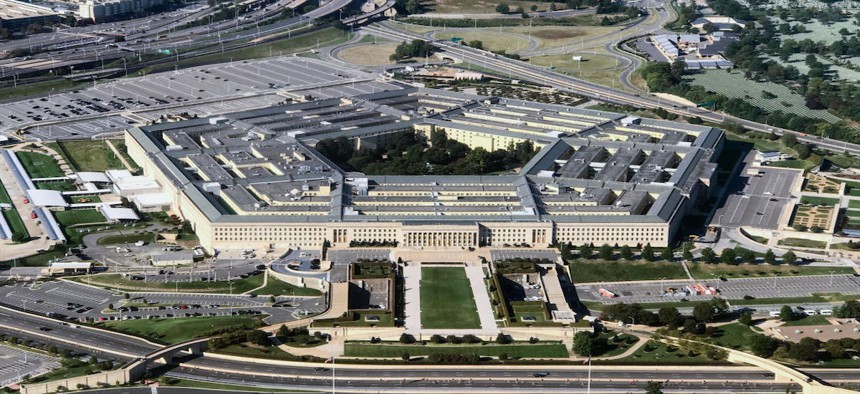DOD’s IT Modernization Efforts Need Data Analytics, Workforce Upskilling

Aerial view of the Pentagon building photographed on Sept. 24, 2017. Bill Clark/CQ Rollcall via Getty Images
The latest report from the Government Accountability underscores Defense’s ongoing need to leverage resources, personnel, and performance markers to successfully modernize its IT infrastructure.
As sophisticated software systems continue to be paramount to national and individual safety, the U.S. Department of Defense needs to continue bridging gaps in its internal software infrastructure, particularly surrounding how agency staffers implement modernization and acquisition goals.
The Government Accountability Office offered oversight into Defense’s effort to update its internal software systems that are critical to national security operations. Building off of prior technology modernization strategies released by Defense, the GAO published a report highlighting the next key steps in Defense’s ongoing effort to improve its software ecosystem.
“DOD has outlined transformational plans to continue software modernization,” the GAO introduction reads. “However, DOD has yet to take certain steps recommended by GAO’s past work to position itself to effectively implement its planned reforms.”
While acknowledging that Defense has implemented previous recommended actions and issued previous warnings that a cohesive modernization plan will take time to fully implement, GAO authors honed in on several components that Defense should incorporate into its modernization effort. One such recommendation is developing actionable performance metrics to gauge its progress.
“Our past work has found that agencies should establish clear outcome-oriented goals to help identify what they are trying to achieve with their reform efforts and should establish performance measures to assess the extent to which they are meeting their goals,” the report reads. “DOD has yet to establish performance measures to assess progress toward its goals.”
Defense officials reportedly told the GAO that it is in the process of developing accurate performance metrics. However, the report still states that Defense has yet to identify the specific steps it will take to develop these quantifiers.
“DOD’s key strategies do not establish any guidelines for the characteristics of performance measures to be developed,” the report said.
The oversight report also recommended using data as a component to effectively measure the progress of new software implementation and other workforce development. Despite similar recommendations, the GAO reiterated its support for data analytics as part of Defense’s internal evaluations.
“Our prior work emphasizes the importance of developing an implementation plan with key milestones and deliverables and putting in place processes to collect the needed data and evidence to effectively measure the reforms’ outcome-oriented goals,” the report said. “DOD has yet to describe how the department plans to collect the data necessary to measure progress in achieving strategic goals.”
The report also noted that deadlines within Defense to develop implementation plans have been delayed and extended.
Recommendations also touched on cultivating a strong workforce to address ongoing gaps in critical software modernization knowledge. Upskilling employees to become more comfortable in Agile and DevSecOps fundamentals was one recommendation the GAO highlighted, as well as hiring contractors that work within modern application development rather than legacy systems. Ideally, Defense would cultivate a workforce to organize a specialized implementation team to oversee modernization efforts.
“Taking action to develop meaningful performance measures, establish data collection strategies for measuring performance, and finalize implementation plans can help DOD track progress towards achieving and implementing software modernization goals,” the report concluded. “Further, building a workforce—with critical skills and competencies—that can implement these reforms is foundational to all of DOD’s planned actions.”
Defense leadership broadly concurred with the recommendations laid out in the report, partially concurring with the recommendation surrounding data analytics, as well as regarding its staffing efforts.
This report comes as Defense, along with other federal entities, are looking toward updating their software with emerging technologies, particularly artificial intelligence.
Last week, Defense’s Chief Information Officer John Sherman noted that the agency aims to shift its digital systems to a zero trust framework by 2027 amid a high threat level of ransomware and cybersecurity attacks.



